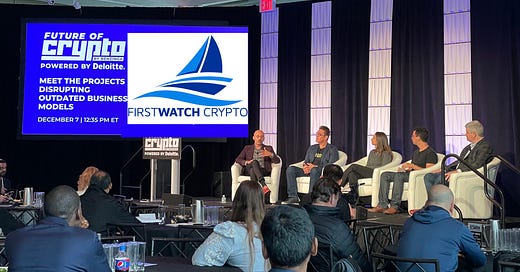The TL;DR: the future of crypto is diverse and promising. Executives, investors, and developers came together for a full day of discussion about FTX, tokenization, building crypto on-ramps, and more.
The future of crypto is promising.
FirstWatch witnessed the excitement about digital assets at the Future of Crypto conference last week, put on by Benzinga at Pier 60.
The event made it abundantly clear: the digital asset sector continues to grow and evolve.
A few specific discussions stood out to us that are representative of what we see as the future. The first was the opening discussion on FTX.
FTX
Kevin O’Leary and Anthony Scaramucci offered a keynote to a packed room anxiously waiting to hear about the FTX fallout from the two insiders.
Both were financially involved with FTX: O’Leary was an investor in and spokesperson for the failed exchange. Scaramucci, on the other hand, sold a 30% stake in his Skybridge fund to FTX and purchased $10 million worth of FTT tokens.
O’Leary was straightforward: “Explain what happened,” calling for FTX to comply with the investigations. Investors and account holders alike don’t know where the funds are right now. O’Leary is committed to figuring it out and letting the facts speak for themselves on whether fraud was perpetrated.
"I'm one pissed off cowboy with a lot of lawyers,” O’Leary emphasized.
Scaramucci showed candor as he stood by his due diligence on FTX. For those who claim to have seen the red flags and that the collapse should have been seen as obvious — he stated that those red flags weren’t obvious at the time and it’s easy for them to revise history. Scaramucci is known to be an aggressive investor and reaffirmed that he will continue to take big swings like FTX.

Both presenters agreed: “now we look like idiots,” but this is not the end of the story. It may take years, but the data will eventually come out and we will all know the truth.
Institutional Perspective
Institutional appetites still exist. Anthony Scaramucci mentioned that his former employer Goldman Sachs is investing tens of millions of dollars into blockchain.
Offering an additional traditional institutional perspective, Grace Berkery of Mastercard explained how institutions are looking at the current environment as an opportunity and a time to reset. Future emphasis will be less about hype and buzzwords and more on impact, because Mastercard and many institutions, she explained, understand the promise in the underlying technology, and they won’t shy away. “Even if it’s only investing 1% of their money or their time into the space.”
“Be part of the inevitable,” chimed in Matt Higgins of RSE Ventures, encouraging teams to work towards their vision of what blockchain can enable.
Another common thread for the day was user onboarding: getting individuals and institutions comfortable with using DeFi and blockchain. The legacy systems are not built for decentralized finance, but Morgan Krupetsky, director of business development for Ava Labs, aptly said that “DeFi will become Fi,” meaning that the newness of decentralization will become more and more commonplace as interfaces become more user-friendly. We are watching closely as new on-ramps come online and on-chain activity bottoms.
Ripple’s Boris Alergant stated three requirements for such a transition to take place: proper regulation, a smooth user experience, and safety and security for consumers. “It’s going to be a more gradual shift [to web3]. We need to get to web 2.1, 2.2, to 2.5 before we can even get to web3.”
Tokenization of Real-World Assets
The integration of real-world assets with the blockchain was a popular topic, and one that we believe will become a major theme of 2023.
What are the applications? They’d include the tokenization of stocks and equities or the creation of dynamic NFTs or liquid assets from infrastructure systems.
“The most interesting use-case of NFTs is not art.”
On the topic of possibilities, Jordan Fried of Immutable Holdings noted: “The most interesting use-case of NFTs is not art. The global market cap of NFTs will far exceed that of crypto. Most wealth is stored in illiquid assets — like membership interests in limited liability companies or ownership of land — that manifests in the form of NFTs representing that share certificate or that ownership or the title deed.”
Tokenizing real-world assets is complicated. Not only does the process require building new technology, but also integration with legacy systems. Many of the presenters have grand visions but were careful to recognize key needs to realize the world in our imaginations.
Trevor Bacon of Parcl noted, “On one hand it’s the infrastructure needed to bring assets on-chain or tokenize them. You’re dealing with legacy infrastructure. On the other hand, it’s a scale issue. To get assets on-chain you need money and time, both of those are scarce resources.”
The Future of Crypto Conference hit on three main themes that have been top of mind: FTX, on-ramps, and tokenization. 2023 will see more growth and change for an industry that is finding its footing on a bigger stage.
A replay of the entire day’s events can be found here.



